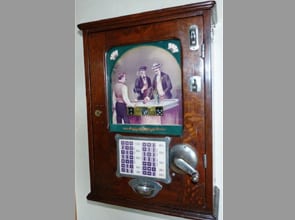
The Domino – an Unusual European Slot Machine Imported to the U.S.
By Rick Crandall
The Domino is a unique combination that is part vintage coin-op, payout gambling machine, part automata and part machine art that is also a standout as one of the few, if not the only payout slot machine designed and manufactured in Europe and imported to the U.S. market.
The basic mechanism appears in several incarnations and was sold under several names including Domino (the name used in the U.S. and maybe elsewhere) Lucky Dice, and Le Juge de Pais (in France) which means Magistrate in French. The Magistrate name is a curious choice in that the machine depicts a bar scene, not a court-room scene. The Domino name has also long been thought to be an anomaly, in that the animated scene is all about throwing dice from a dice cup. However the spinning reels and award card do have the same dot patterns as dominoes.
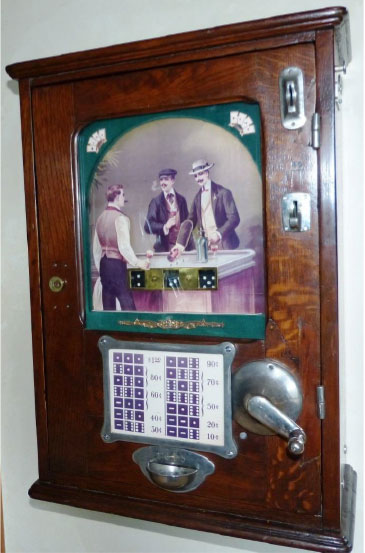
The Domino or Lucky Dice has a cosmopolitan background: it was invented by an Englishman (Edward Charles Bignell), who was based in France (9, Boulevard du Temple, Paris) but it was manufactured in Germany by Jentzsch und Meerz of Leipzig, but never sold in Germany due to its strict laws. The German-built version was distributed mainly in the U.S. and England.
Jentzsch & Meerz, produced at least 20 different machines during the period 1912 – 1928. Other machines made by Jentzsch & Meerz include Puce, La, Airship Profit Sharer, Le Dirigeable, Elite, Les Footballeurs, Iris, Volta, Allwin Reserve (with Electric Shock), and Bajazzo (Clown). Some of these also reused the Domino mechanism packaged with different human factors to attract different user types.
Bignell was behind some very fine wall-mounted coin-op machines. For some reason wall-mounted slot machines became popular in Europe as early as 1904 and continued as a machine style all the way into the 1960’s. In 1904 Bignell worked with George Haydon of Haydon & Urry fame on an automatic coin payout apparatus (which was patented # FRD335226), and in 1911 with Joseph Soukhostavsky on the “Courses de Longchamp” horse race roulette (Pat FR424379) and in 1929 on “Tivoli Billiards” (Pat GB332881).
It seems likely that the first versions of this machine may have been actually made in France and subsequently Bignell took his design to the famous German manufacturer for a more robust design and scalable manufacturing process in order to ramp up production for the UK and American market. The few French examples look early and more primitive – with the simpler, single payout slides and wooden reels.
There is evidence that the “export” Domino was first produced in 1927 and the simpler French machines were earlier.
Two ads give us some additional information:
One with the smaller knob, a simpler award-card and a pump instead of a clock, and offered in three versions:
There are some unconfirmed indications this is an earlier machine dating as far back as 1912.
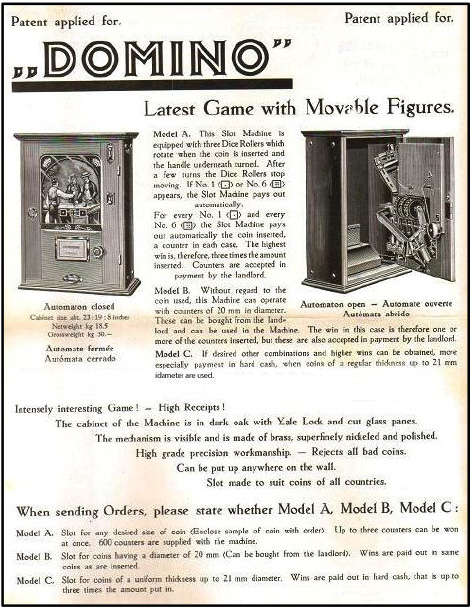
Earlier ad from Jentzsch & Meerz, Leipzig, Germany
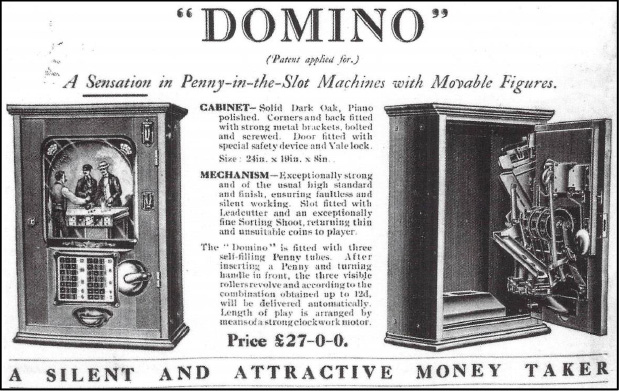
A later ad, 1928 by Jentsch & Meerz shows a machine with the bigger crank, a clock instead of a pump and a more elaborate award card for up to 12 winning combinations.
Below: the upper earlier mech with pump circled & smaller knob; the lower later mech has a clock timing the mech & larger crank.
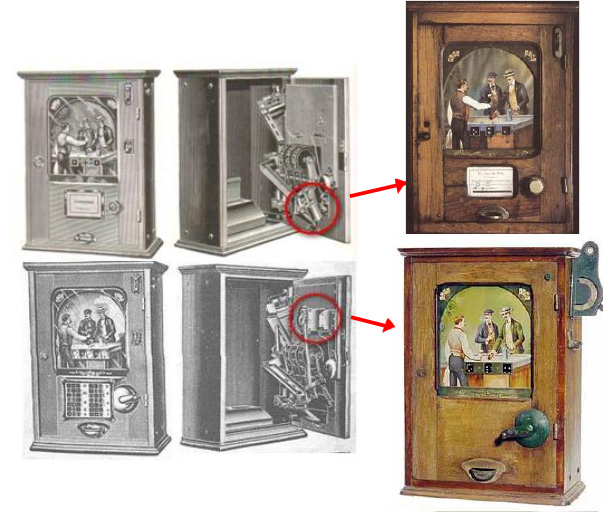
The American distributor, Domino Co., 26th and Huntington Streets, Philadelphia called itself and the machine “Domino” in their ads. The Company changed its name to the Keystone Novelty & Mfg. Co. in 1929. It may have been Keystone who later christened the machine “Lucky Dice”, because the payout card they produced had that name on it. The name change may also have been motivated by the fact that the London Automatic Machine Co. (originally Handan-Ni) was already marketing a game called “Domino”.
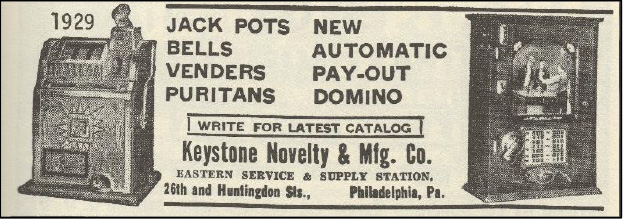
Domino 1929 ad by Keystone Novelty in the U.S.
The machine was sold in relatively limited numbers in that by the late 1920’s it was competing with mint, gum and candy vendors, jackpot-fronts and revamps of all types. The Domino was a simple three-reeler throwback to earlier times, but with attractive cosmetics and some features normally associated with automata that was decidedly European. Automated figures were highly popular from the latter part of the 1800’s throughout Europe. The use of automated figures in machines got its first start in European Fortune-telling arcade machines. Also many European automatic music machines had animated art-glass scenes with moving people, waterfalls, airplanes, etc. to capture attention as the music played.
Operation and Mechanism
The basic Domino mechanism has several cosmetic variations – some being soccer scenes (possibly a British revamp?)
and another of a bar-and-dice theme with two gents, one throwing the dice and the other toasting the winner when a winning combination occurs on the reels. It’s an impressive scene linked to the normal gambling spin of the reels – especially upon a win.
The entire front of the device is a door hinged on the right side and locked on the left. All the mechanism is mounted on the door and makes the machine very tippy when the door is opened if the machine is not firmly wall-mounted.
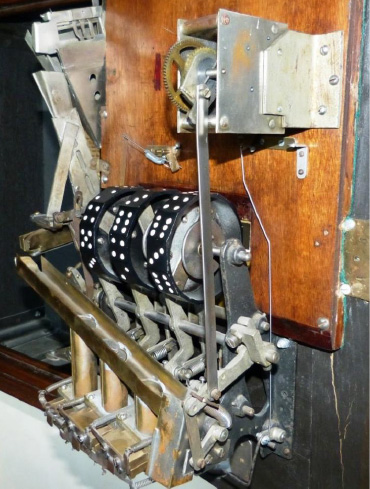
It has all the necessary components compactly designed and very well integrated with the moving scene – coin slot, coin return, payout cup, award card, three-reel window and of course the moving bar scene.
Internally the mechanism is clever and different. For example, the reels stop right to left (facing machine front) which is the opposite of U.S. designed three-reelers (but then again in the U.K. they drive on the left side of the street!).
Payout occurs as soon as any one of the reels stop on a winning dice face assuming it’s one of the combinations where the other two can be wild cards. The action starts with insertion of a nickel and a full turn of the crank. As the crank is turned, the gen who is the dice thrower shakes the dice cup back and forth with animated arm motion. Then when the reels start spinning, the arm thrusts forward as though to eject the dice onto the bar top.
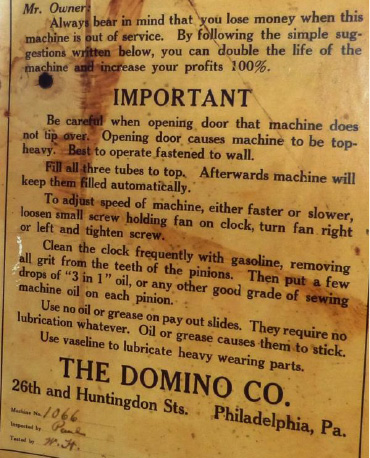
Any winning combination causes the right-hand gent (the bartender) with the glass of spirits to raise his glass as a toast to the winner as the payout drops to the center cup. There is some realism in the spinning reels as they are made of cast aluminum with actual concave dots making up the dice faces just like real dice. This is a dice machine, not a domino machine despite its name. The payout slides are all interlocked so that if there actually is a payout determine on the third reel (far right) the second reel cannot pay. Then if the second reel does not pay, no payout can occur on the first reel. Each reel has 12 possible stopping positions making for 1728 possible stopping positions. The top payout is $1 in nickels arising from each of the three reels stopping on a 1–spot. Payouts are typical ranging down to 2 nickels for a six-spot on one reel and anything on the other two reels.
The reels had to be spaced further apart on the later, higher payout version to make room for the extra payout detecting levers. The three payout tubes had two coin slides below them, each of which was the thickness of two pennies. This meant that the reels no longer aligned properly with the apertures originally drawn on the artwork. To overcome this, a brass plate with three suitably spaced openings was pinned over the top of the picture. The heavier mechanism also required the larger cranking handle to operate it.
Several were converted in the 1980s using photocopied artwork which reproduces a distinctive stain across the top of the background (marked in red in the pic). In the 1990s a hand-painted copy of the artwork was made and photographic prints of this were used to convert a few more. This artwork was more vibrant than the earlier photocopies but the artist also reproduced the top stain. These revamped-revamps often lack the little playing card corner spandrels, fancy brass decorative bottom trim and the linkages to animate the figures.
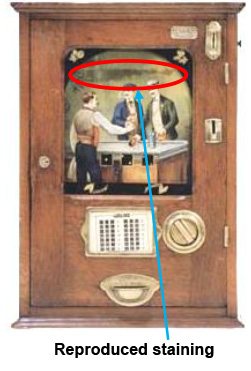
From Les Machines a Sous – Jean Lemaitre, P85 Le Juge de Paix
“The Magistrate” is the name of a game very widespread in the French cafe at the beginning of the century which explains the decor, but has nothing to do with Justice. It is a superb machine. This is one of the few European models that were distributed in the U.S.
The 100 Most Collectible Slot Machines, Vol II; Richard Bueschel, P87
The action of the Domino is almost indescribable, it’s so clever! When you drop a coin in the slot and crank the handle, the guy on the right shakes a dice cup on the bar and three reels at the edge of the bar spin, stopping one, two three. If the dice symbols match a winning combination, the bartender on the left raises his wine glass in a toast. With the wine glass up the machine pays off as the glass is lowered. Fantastic!
The first one found in modern times occurred when collector Burton A. Burton chased down John Watling of Watling Mfg. Co. some years before Watling died. Burton was hoping he’d still have some nifty Watling machines around, but instead Watling had a Domino! Since then others have surfaced in the U.S. and in the U.K.
The DOMINO lays claim to several elements of uniqueness – in particular it is one of not many examples where art and machines intersect due to a blend of European tastes and the American thirst for “fun and games.”


